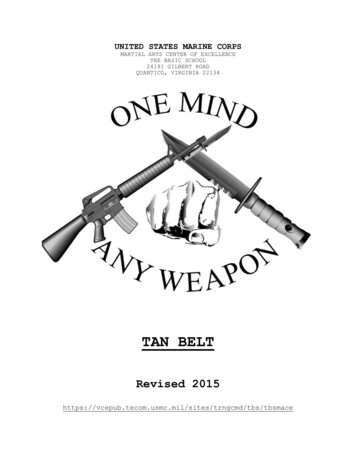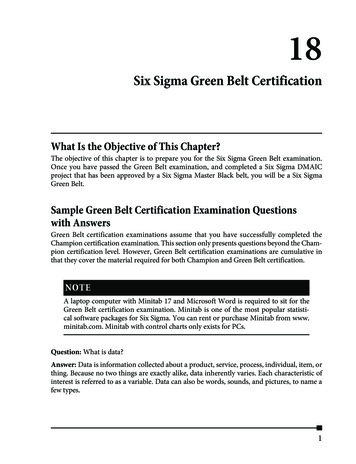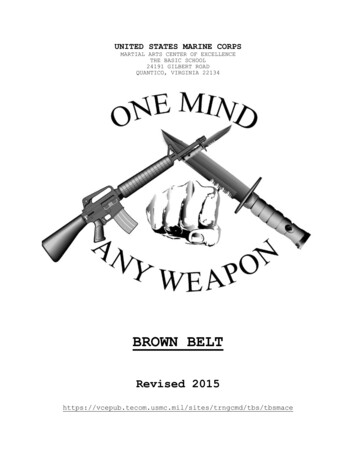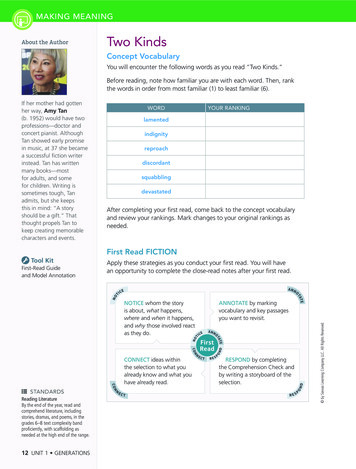
Transcription
UNITED STATES MARINE CORPSMARTIAL ARTS CENTER OF EXCELLENCETHE BASIC SCHOOL24191 GILBERT ROADQUANTICO, VIRGINIA 22134TAN BELTRevised s/tbsmace
TABLE OF CONTENTSLesson IDLesson TitlePage #MCCS-TAN-1001FUNDAMENTALS OF MARINE CORPS MARTIAL ARTS.3MCCS-TAN-1002PUNCHES.9MCCS-TAN-1003BREAK FALLS.19MCCS-TAN-1004BAYONET TECHNIQUES.31MCCS-TAN-1005UPPER BODY STRIKES.39MCCS-TAN-1006LOWER BODY S.61MCCS-TAN-1009COUNTERS TO STRIKES.69MCCS-TAN-1010COUNTERS TO CHOKES AND HOLDS.77MCCS-TAN-1011UNARMED MANIPULATIONS.83MCCS-TAN-1012ARMED MANIPULATIONS.91MCCS-TAN-1013KNIFE TECHNIQUES.99MCCS-TAN-1014WEAPONS OF OPPORTUNITY.105MCCS-TAN-1015STRUCTURE AND HISTORY OF MCMAP.111MCCS-TAN-1016RESPONSIBLE USE OF FORCE.119MCCS-TAN-1017PUGIL STICK TRAINING.125MCCS-TAN-1018BODY SPARRING.133GUIDED DISCUSSION 1:MARINE CORPS CORE VALUES.139GUIDED DISCUSSION 2:SEXUAL HARASSMENT.145GUIDED DISCUSSION 3:DRUG ABUSE.153GUIDED DISCUSSION 4:EQUAL OPPORTUNITY.161GUIDED DISCUSSION 5:FRATERNIZATION.1671
2
MCCS-TAN-1001UNITED STATES MARINE CORPSMARTIAL ARTS CENTER OF EXCELLENCETHE BASIC SCHOOL24191 GILBERT ROADQUANTICO, VIRGINIA 22134LESSON PLANFUNDAMENTALS OF MARINE CORPS MARTIAL ARTSMCCS-TAN-1001TAN BELTAPPROVED BY:LtCol (Ret) Shusko, J. C.3DATE: 07/08/2015
MCCS-TAN-1001UNITED STATES MARINE CORPSMARTIAL ARTS CENTER OF EXCELLENCETHE BASIC SCHOOL24191 GILBERT ROADQUANTICO, VIRGINIA 22134INSTRUCTOR PREPARATION GUIDELESSON TITLE:Fundamentals of Marine CorpsMartial ArtsLESSON DESIGNATOR:MCCS-TAN-1001TOTAL LESSON TIME:1 hourREFERENCES:MCO 1500.59NAVMC 3500.41MCRP 3-02BPERSONNEL REQUIRED:One instructor and assistantFACILITIES:Soft footed training areaREVIEW COURSE MATERIALS: Review Lesson PlanADD PERSONALIZATION: Personalize the lesson by adding subject matter detail,personal experiences, examples, and questions.MATERIALS/EQUIPMENT: NoneSETUP AND PLANNING: Reserve Training Area Conduct Rehearsals2
MCCS-TAN-1001INTRODUCTION(5 MIN)1. GAIN ATTENTION. There are several fundamentals of thephysical discipline in our martial arts used throughout any typeof confrontation or situation. These fundamentals form the basisfor all martial arts instruction and techniques. The properexecution of these fundamentals will enable you to effectivelyperform martial arts techniques that may save your life or thelives of fellow Marines.2. OVERVIEW. Good morning, my name is . This lessonwill cover the fundamentals of MCMAP and the mental and characterdisciplines of MCMAP.3.POSITIONSINSTRUCTOR NOTE: Assign demonstration and practice positions.Ensure students have enough space, and can see and hear theinstructor.4.SAFETY.To prevent injury, ensure the following:a.Start slowly and increase speed with proficiency.b.Techniques will be performed on a soft-footed area.TRANSITION. Now that you know what will be covered are there anyquestions? Let’s discuss the purpose of MCMAP.BODY1.(45 MIN)EXPLAINa. Purpose. The purpose of the Marine Corps Martial ArtsProgram is to execute unarmed and armed techniques to use lethaland non-lethal force across a spectrum of violence.(1) Unarmed techniques include hand-to-hand combat anddefense against hand-held weapons.(2) Armed techniques include techniques applied with arifle, pistol, knife, or weapon of opportunity.b. Principles. The principles of MCMAP are the ranges ofclose combat, the weapons of the body, and the target areas ofthe body.(1) Ranges of Close Combat. There are three ranges inwhich close combat engagements can take place: long range, midrange, and close range. In any engagement, these ranges may blur3
MCCS-TAN-1001together or may rapidly transition from one to another and thenback again until the aggressor is defeated or the situation ishandled.(a) Long Range. At long range, the distance betweencombatants allows engagement with a rifle, bayonet, or weapon ofopportunity.(b) Mid-Range. At mid-range, the distance betweencombatants is such that they can engage each other with knives,punches, or kicks.(c) Close Range. At close range, the distancebetween combatants is such that they can grab a hold of eachother and may involve elbow and knee strikes and grappling.(2) Weapons of the Body. The weapons of the body aredivided into two groups: the arms and legs.(a) Arms. The arms are the most commonly usedweapons of the body, consisting of the hands and elbows.1. Hands. The hands are the instant responseweapon of the body. They can be used for striking, choking,grabbing, and wielding a weapon.2. Elbows. The elbows do not have all thefunctions of the hands, but they can deliver more force at closerange. The striking surface is also stronger because the bonesof the elbows are larger and harder than those in the hands.(b) Legs. The legs are considered the most powerfulweapon of the body, consisting of the feet and knees.1. Feet. The feet are not easily employed andrequire training, coordination, and skill to be used as a weapon.They can be used for kicks and stomps to generate more power thanstrikes with the arms. The shins may also be utilized as astriking surface.2. Knee. The largest amount of power can bedelivered from knee strikes. Knee strikes are most effectivewhile fighting close to your aggressor where kicks areimpractical.(3) Target Areas of the Body. During close combat, theparts of the aggressor's body readily accessible will vary witheach situation and throughout a confrontation. The goal is toattack those areas that are easily accessible and will causedamage to the aggressor. These areas are divided into five majorgroups: head, neck, torso, groin, and extremities.4
MCCS-TAN-10011. Head. The vulnerable regions of the head arethe eyes, temple, nose, ears, and jaw. Massive damage to theskull can kill an aggressor.2. Neck. The entire neck is vulnerable because itcontains vital blood vessels, the trachea, and the upper portionof the spine.3. Torso. The vulnerable areas of the torso are theclavicle, solar plexus, and internal organs.4. Groin. The groin area is a very sensitive targetarea made of soft tissue. This is a good target area because itcontains large arteries and nerves. An attack can be quicklydebilitating for both genders.5. Extremities. The arms and legs are importanttarget areas because they are the aggressor’s weapons. Attackswill not usually cause death but can lead to loss of motorfunction of the extremity.c. Fundamentals. The basic fundamentals for the MarinesCorps Martial Arts Program are the basic warrior stance andangles of movement.(1) Basic Warrior Stance. The basic warrior stanceprovides the foundation for all movement and techniques in closecombat situations. Marines must be able to assume the basicwarrior stance instinctively. All movement should start and stopin the basic warrior stance.(2) Angles of Movements. The worst place to be in aconfrontation is directly in front of an aggressor. Movementmakes different target areas available, enables the use ofdifferent techniques, and increases power. Moving at a 45-degreeangle is the best way to avoid and aggressor’s strike and gainthe advantage.TRANSITION: We have covered the purpose, principles, andfundamentals, are there any questions? I will now demonstratethe first technique.2.DEMONSTRATEINSTRUCTOR NOTE: Demonstrate only one technique at a time.Do not explain the steps or open the class for questions.INTERIM TRANSITION:3.Go to practice position one.IMITATE5
MCCS-TAN-1001a.Basic Warrior Stance.(1) Place your feet shoulder width apart, take a halfstep forward with your left foot, and turn your hips andshoulders approximately 45-degree angle to the right.(2) Distribute your body weight evenly by bending theknees slightly and adjusting your feet in order to maintain yourbalance.(3) Loosen your fists and bring your hands up to chinlevel or high enough to protect the head without obstructing yourvision.(4) Tuck your elbows in close to your body to protectyour body.(5) Tuck your chin down to take advantage of the naturalprotection provided by your shoulders.b. Angles of Movement. There are eight angles of movementthat can be executed in 360 degrees around an aggressor.Xopponent(1) Forward. Move the left foot forward approximately 12to 15 inches. As soon as the left foot is in place, quickly stepwith the right foot 12-15 inches returning to the basic warriorstance.6
MCCS-TAN-1001(2) Backward. Move the right foot backward approximately12-15 inches. As soon as the right foot is in place, quicklybring the left foot in front of the right foot to return to thebasic warrior stance.(3) Left. Move the left foot to the left approximately12 to 15 inches. As soon as the left foot is in place, quicklybring the right foot behind the left foot to return to the basicwarrior stance.(4) Right. Move the right foot to the rightapproximately 12 to 15 inches. As soon as the right foot is inplace, quickly bring the left foot in front of the right foot toreturn to the basic warrior stance.(5) Forward Left. Move the left foot forward at a 45degree angle from your body, approximately 12 to 15 inches,keeping your toe pointed toward the aggressor. As soon as theleft foot is in place, quickly bring the right foot behind theleft foot to return to the basic warrior stance.(6) Forward Right. Move the right foot forward at a 45degree angle from your body, approximately 12 to 15 inches. Assoon as the right foot is in place, quickly bring the left foot,toe pointing toward the aggressor, in front of the right foot toreturn to the basic warrior stance.(7) Backward Left. Move the left foot backward at a 45degree angle from your body, approximately 12 to 15 inches,keeping your toe pointed toward the aggressor. As soon as theleft foot is in place, quickly bring your right foot behind theleft foot to return to the basic warrior stance.(8) Backward Right. Move the right foot backward at a45-degree angle from your body, approximately 12 to 15 inches.As soon as the right foot is in place, quickly bring the leftfoot, toe pointing toward the aggressor, in front of the rightfoot to return to the basic warrior stance.4.PRACTICEINSTRUCTOR NOTE: Fault check student proficiency and safety.TRANSITION: We have learned the fundamentals of MCMAP, are thereany questions? The physical discipline is only one aspect ofMCMAP, which must be combined with the mental and characterdisciplines.5. TIE-IN (MENTAL AND CHARACTER DISCIPLINES OF MCMAP). TheMarine Corps Martial Arts Program is built on the foundation ofthe three disciplines: mental, character, and physical. Each7
MCCS-TAN-1001discipline is presented systematically to Marines at each beltlevel. Many skills specific to one discipline reinforce thestrengths of the other disciplines, creating a synergistic effectwhere the program as a whole is stronger than its individualparts.a. Mental Discipline. The mental discipline is taughtthrough tie-ins, warrior studies, and martial culture studies;and has two main components: warfighting and professionalmilitary education (PME). This encompasses the study of the artof war, the professional reading program, Marine Corps CommonSkills, decision making, the historical study of war, the tacticsand techniques of maneuver warfare, risk management assessment,force protection, and the study of Marine Corps history, customs,courtesies and traditions. The mental discipline creates asmarter Marine, capable of understanding and handling thecomplexity of modern warfare, a Marine who is tactically andtechnically proficient, and one who is capable of decision makingunder any condition from combat to liberty. This training, whichbegins with the transformation of recruit training and officercandidate school, serves as the foundation of the futureleadership of our Corps.b. Character Discipline. The character discipline is alsotaught through tie-ins, warrior studies, and martial culturestudies; and has two main components: the Marine Corps CoreValues program and the Marine Corps Leadership Program. Itencompasses Troop Information training as well as the study ofthe human dimensions of combat. Designed to instill the MarineCorps Ethos into every Marine, character discipline is thespiritual aspect of each Marine and the collective spirit of theCorps. The components of character discipline instill in everyMarine the warrior spirit we all share, and emphasizes the bestof our traditions for developing esprit de corps, camaraderie anda warrior mindset. Building the character of Marines developsthem into ethical warriors who embody our core values, are selfdisciplined, confident, and capable of making the right decisionunder any condition from combat to liberty.TRANSITION: We have discussed the mental and characterdisciplines of MCMAP, are there any questions?SUMMARY(10 MIN)During this period of instruction we have covered thefundamentals of MCMAP and the mental and character discipline ofMCMAP. I am now confident you will be able to use thesefundamentals to build your close combat skills.INSTRUCTOR NOTE: Provide follow-on instructions.8
MCCS-TAN-1002UNITED STATES MARINE CORPSMARTIAL ARTS CENTER OF EXCELLENCETHE BASIC SCHOOL24191 GILBERT ROADQUANTICO, VIRGINIA 22134LESSON PLANPUNCHESMCCS-TAN-1002TAN BELTAPPROVED BY:LtCol (Ret) Shusko, J. C.9DATE: 07/09/2015
MCCS-TAN-1002UNITED STATES MARINE CORPSMARTIAL ARTS CENTER OF EXCELLENCETHE BASIC SCHOOL24191 GILBERT ROADQUANTICO, VIRGINIA 22134INSTRUCTOR PREPARATION GUIDELESSON TITLE:PunchesLESSON DESIGNATOR:MCCS-TAN-1002TOTAL LESSON TIME:1 hour 45 minutesREFERENCES:MCO 1500.59NAVMC 3500.41MCRP 3-02BPERSONNEL REQUIRED:One instructor and assistantsFACILITIES:Soft footed training areaREVIEW COURSE MATERIALS: Review Lesson PlanADD PERSONALIZATION: Personalize the lesson by adding subject matter detail,personal experiences, examples, and questions.MATERIALS/EQUIPMENT: Black Leather Gloves Striking PadSETUP AND PLANNING: Reserve Training Area Conduct Rehearsals10
MCCS-TAN-1002INTRODUCTION(5 MIN)1.GAIN ATTENTION. If a Marine is unarmed in a close combatscenario, they must be able to use basic punches to defendthemselves. Punching is a reflexive defense mechanism used as anatural reaction to a threat. There are techniques for correctlydelivering a punch that maximize the damage to an aggressor whileminimizing the risk of injury to you. We must also train ourcore values to develop our character.2. OVERVIEW. Good morning, my name is . This lessonwill cover tan belt punches and the Marine Corps core values.3.POSITIONSINSTRUCTOR NOTE: Assign demonstration and practice positions.Ensure students have enough space, and can see and hear theinstructor.4.SAFETY.To prevent injury, ensure the following:a.Start slowly and increase speed with proficiency.b.Never execute techniques at full force or full speed.c. When executing strikes, ensure the joints are keptslightly bent to avoid hyperextension.d.Training will be conducted in three stages.(1) Marines will execute techniques in the air.(2) Marines will practice strikes on a pad or dummy.(3) Marines will practice during free sparring.TRANSITION. Now that you know what will be covered are there anyquestions? Let’s discuss the purpose of punches.BODY1.(90 MIN)EXPLAINa. Purpose. The purpose of punches is to stun your enemy orto set him up for a follow on technique.b. Principles. The principles for punches are musclerelaxation, making a fist, weight transfer, rapid retraction, andtelegraphing.11
MCCS-TAN-1002(1) Muscle Relaxation. Muscle relaxation must beemphasized at all times during instruction on punches. Thenatural tendency in a fight is to tense up, which results inrapid fatigue and decreased power generation. The fighter whocan remain relaxed during a close combat situation generatesgreater speed, which results in greater generation of power.Relaxing your forearm generates speed and improves reaction time.At the point of impact, clench your fist to cause damage to theaggressor and to avoid injury to your wrist and hand.(2) Making a Fist. Punches are executed using the basicfist. Curl the fingers naturally into the palm of the hand andplace the thumb across the index and middle fingers. Do notclench the fist until movement has begun. This increasesmuscular tension in the forearm and decreases speed and reactiontime. Just before impact, apply muscular tension to the hand andforearm to maximize damage to the aggressor and reduce injury tothe Marine.(3) Weight Transfer. Weight transfer is necessary togenerate power in a punch. This is accomplished by rotating thehips and shoulders into the attack, moving your body massforward, or dropping your body weight into an aggressor. Yourbody’s mass can be transferred into an attack from high to low orfrom low to high.(3) Rapid Retraction. When delivering a punch, quicklyreturn to the basic warrior stance. Rapid retraction enables youto protect yourself from your aggressor’s counter-attack andprevents the aggressor from being able to grab your hand or arm.This also chambers the arm in preparation for delivering asubsequent punch.(4) Telegraphing. Telegraphing a strike informs theaggressor of your intentions to launch an attack through yourbody movements. Untrained fighters will often telegraph theirattack by drawing their hand back, changing facial expression,tensing neck muscles, or twitching. These movements, howeversmall, immediately indicate an attack is about to be delivered.Telegraphing against a trained fighter may enable him to evade orcounter your attack. Even an untrained fighter may be able tominimize the effect of your attack. Staying relaxed helps toreduce telegraphing.c. Fundamentals. The fundamentals for punches are thestriking surface and target areas.(1) Striking Surface. The striking surface for allpunches is the first two knuckles of your fist. Contact with thefist should be made with the knuckles of the index and middlefinger in line with the wrist to avoid injury to the wrist.12
MCCS-TAN-1002(2) Target Areas. Target areas that should be attackedwith punches are soft tissue areas such as the nose, jaw, andthroat. The torso can also be attacked as a secondary target.TRANSITION: We have covered the purpose, principles, andfundamentals, are there any questions? I will now demonstratethe first technique.2.DEMONSTRATEINSTRUCTOR NOTE: Demonstrate only one technique at a time.Do not explain the steps or open the class for questions.INTERIM TRANSITION:3.Go to practice position one.IMITATEa. Lead Hand Punch. The lead hand punch is a snappingstraight punch executed by the forward or lead hand. It is afast, unexpected punch designed to stun an aggressor and to setup for a follow-on techniques. A lead hand punch concealsmovement and allows you to get close to the aggressor.(1) Assume the basic warrior stance.(2) Snap your lead hand out to nearly full extension,while rotating your palm to the deck.(3) Keep your rear hand in place to protect your head.(4) Rapidly retract to the basic warrior stance.FAULT CHECK: A common mistake is to pull the fist back low,leaving you open to a counter attack. Ensure students do nothyperextend their elbows.b. Rear Hand Punch. The rear hand punch is a snapping punchexecuted by the rear hand. It is a power punch designed toinflict maximum damage on your aggressor. Its power comes frompushing off your rear leg and rotating your hips and shoulders.(1) Assume the basic warrior stance.(2) Forcefully rotate your hips and shoulders toward theaggressor and thrust your rear hand straight out, palm down, tonearly full extension.13
MCCS-TAN-1002(3) Shift your body weight to your lead foot whilepushing off on the ball of your rear foot.FAULT CHECK: Your rear heel may raise or flare off the deck.(4) Keep your lead hand in place to protect your head.(5) Rapidly retract to the basic warrior stance.FAULT CHECK: A common mistake is to pull the fist back low,leaving you open to a counter attack. Ensure students do nothyperextend their elbows.c. Uppercut. The uppercut is a powerful punch originatingbelow the aggressor's line of vision. It is executed in anupward motion traveling up the centerline of the aggressor'sbody. It is delivered in close and usually follows a preparatorystrike that leaves the target area unprotected. When deliveredto the chin or jaw, the uppercut can render an aggressorunconscious, cause extensive damage to the neck, and/or sever thetongue.(1) Assume the basic warrior stance.(2) Rotate your fist so your palm is facing you. Ensureyour lead hand stays up and in place to protect your head.(3) Power is generated from low to high. Start with yourbody weight low and legs slightly bent. Explode upwards withyour legs, hips, and shoulders, driving your fist straight upthrough the target area.(4) Rapidly retract to the basic warrior stance.FAULT CHECK: A common mistake is to drop the fist to thewaist in an attempt to generate more power. Power isgenerated from the correct use of the lower body.d. Hook. The hook is a powerful punch that is executedclose-in and is usually preceded by a preparatory strike.(1) Assume the basic warrior stance.(2) Rotate your rear fist, this will parallel your fistand forearm to the deck.(3) Power is generated from side to side by driving withyour legs and rotating your hips and shoulders. Your body’s14
MCCS-TAN-1002rotation drives the fist through your target area as your leadhand stays up and in place to protect your head.(4) Rapidly retract to the basic warrior stance.FAULT CHECK: A common mistake is to reach or extend the fistall the way out in an attempt to generate more power. Poweris generated from the rotation of the hips and shoulders.4.PRACTICEINSTRUCTOR NOTE: Fault check student proficiency and safety.After practicing in the air, allow the students to practiceon strike pads. Ensure partners hold the pad correctly.TRANSITION: We have learned punches, are there any questions?Every Marine must be proficient with punches and our core values.5. TIE-IN (CORE VALUES). You already know Marines aredifferent. For each of you, that was one of the reasons thatdrew you to join the Marine Corps. Today we will teach you whatmakes Marines different; our core values. They govern ourbehavior towards one another and everyone else. They guide theactions of a warrior both on and off the battlefield. The MarineCorps core values are honor, courage, and commitment. They arethe foundation of each Marine’s character. Our character is thatpart of us which separates us from others; it is our spirit, andour soul. Our core values give direction to our actions. If welive by them we will always make the right decision and take theright path.a. Honor. As men and women of honor we must be able to keepour reputation untarnished. Our actions must be above reproachand our conduct exemplary. Each day we will have to guardagainst lying, cheating or stealing in order to keep ourreputation, and that of the Corps, untarnished. The core valueof honor has three elements that make the bedrock of ourcharacter. First, Marines are trustworthy. We trust each otherto do the right thing, be honest and truthful with each other.This will allow us to rely on each other in combat and trust eachother with our lives. The warrior understands that trust is afragile thing that must be handled with care because once lost,it is difficult to restore. Second, Marines respect humandignity. We respect each other and understand the diversity ofpeople who make up our nation and Corps contribute to ourstrength and greatness. Third, Marines are accountable. Marinestake responsibility for themselves, their duties, their actions,and their mistakes. They do not blame others for their15
MCCS-TAN-1002shortcomings, nor do they shirk their obligations because theyare unpleasant.b. Courage. As Marines we will be faced on a daily basiswith decisions that require us to exercise one or both of the twotypes of courage; moral and physical courage. We may be facedwith the problem of doing something unpopular that requires themoral courage to stand up to criticism. In another situation wemay find ourselves in combat facing certain death and mustdemonstrate the physical courage to overcome our fear. A soundcharacter built upon our core values will enable us to find thecourage we need.c. Commitment. Each day we will receive new missions toaccomplish with the temptation of taking shortcuts along the way.With a commitment to do what is right the warrior will always beable to confidently accomplish the mission. Commitment meansdetermination and dedication that leads to professionalism andmastery of the art of war. It leads to discipline for unit andself and is the ingredient that enables 24-hours a day dedicationto Corps and Country. It creates pride, concern for others, andan unrelenting determination to achieve a standard of excellencein every endeavor. Commitment is the value that establishes theMarine as a mission focused warrior and a citizen others striveto emulate. Commitment implies hard work, a single-mindeddedication to the tasks at hand, and pride in a quality result.Commitment requires loyalty to the organization, expressed byadhering to Marine Corps requirements and maintaining discipline24-hours a day.d. Our core values are our moral compass. Each of us mustset the proper direction and remain true to that courseconstantly. This application of core values applies toeverything a Marine does. Without these core values to serve asa guide, your conduct would not be that of a Marine. Our corevalues are the foundation of our character development and uponwhich the character discipline of the Marine Corps Martial ArtsProgram is based. Also remember these Core Values are thefoundation upon which we will also build Marine Corps leadership.INSTRUCTOR NOTE: Instructors may enhance this tie-in withadditional material in Appendix A, Guided Discussion 1.TRANSITION: We have discussed the Marine Corps core values, arethere any questions?SUMMARY(10 MIN)16
MCCS-TAN-1002During this period of instruction we have covered punches andcore values. I am now confident you will be able to use thesetechniques to defend yourself if necessary.INSTRUCTOR NOTE: Provide follow-on instructions.17
MCCS-TAN-100218
MCCS-TAN-1003UNITED STATES MARINE CORPSMARTIAL ARTS CENTER OF EXCELLENCETHE BASIC SCHOOL24191 GILBERT ROADQUANTICO, VIRGINIA 22134LESSON PLANBREAK FALLSMCCS-TAN-1003TAN BELTAPPROVED BY:LtCol (Ret) Shusko, J. C.19DATE: 07/09/2015
MCCS-TAN-1003UNITED STATES MARINE CORPSMARTIAL ARTS CENTER OF EXCELLENCETHE BASIC SCHOOL24191 GILBERT ROADQUANTICO, VIRGINIA 22134INSTRUCTOR PREPARATION GUIDELESSON TITLE:Break FallsLESSON DESIGNATOR:MCCS-TAN-1003TOTAL LESSON TIME:2 hours 25 minutesREFERENCES:MCO 1500.59NAVMC 3500.41MCRP 3-02BPERSONNEL REQUIRED:One instructor and assistantsFACILITIES:Soft footed training areaREVIEW COURSE MATERIALS: Review Lesson PlanADD PERSONALIZATION: Personalize the lesson by adding subject matter detail,personal experiences, examples, and questions.MATERIALS/EQUIPMENT: MouthpieceSETUP AND PLANNING: Reserve Training Area Conduct Rehearsals20
MCCS-TAN-1003INTRODUCTION(5 MIN)1. GAIN ATTENTION. If thrown by an aggressor, or you fallduring a struggle, you can become immobilized by breaking a limbor having the wind knocked out of you. A break fall will absorbthe impact of a fall to prevent injury and to allow you to getback on your feet quickly. We must also develop a mentaltoughness and strength of character to deal with the stress andemotional difficulties of life.2. OVERVIEW. Good morning, my name is . This lessonwill cover tan belt break falls and suicide awareness andprevention.3.POSITIONSINSTRUCTOR NOTE: Assign demonstration and practice positions.Ensure students have enough space, and can see and hear theinstructor.4.SAFETY.To prevent injury, ensure the following:a.Start slowly and increase speed with proficiency.b.Train break falls from the lowest position to highest.c.Techniques will be performed on a soft-footed area.TRANSITION. Now that you know what will be covered are there anyquestions? Let’s discuss the purpose of break falls.BODY1.(130 MIN)EXPLAINa. Purpose. The purpose of break falls is to reduce thechance of injury, absorb the impact, and quickly get back to yourfeet if you should fall or are thrown.b. Principles. Break fall techniques use the large musclesof your body (back, thighs, and buttocks) to protect vital organsand bones from injury and immobilization.c. Fundamentals. It is difficult to execute break falls intraining because you need to be thrown to truly execute the breakfall properly, however this would create a potentially hazardouscondition. Instead we will learn and practice the break falls instages.21
MCCS-TAN-1003TRANSITION: We have covered the purpose, principles, andfundamentals, are there any questions? I will now demonstratethe first technique.2.DEMONSTRATEINSTRUCTOR NOTE: Demonstrate only one technique at a time.Do not explain the steps or open the class for questions.INTERIM TRANSITION:3.Go to practice position one.IMITATEa. Front Break Fall. A front break fall is executed tobreak your fall when falling forward. The front break fall istaught and practiced in stages, from the deck and from a kneelingposition. The front break fall will never be executed from thestanding position in training.(1) From the Deck(a) Begin by lying on the deck on your stomac
Marine Corps Martial Arts Program is built on the foundation of the three disciplines: mental, character, and physical. Each INSTRUCTOR NOTE: Fault check student proficiency and safety. MCCS-TAN-1001 8 discipline is presented systematically to Marines at each belt le










